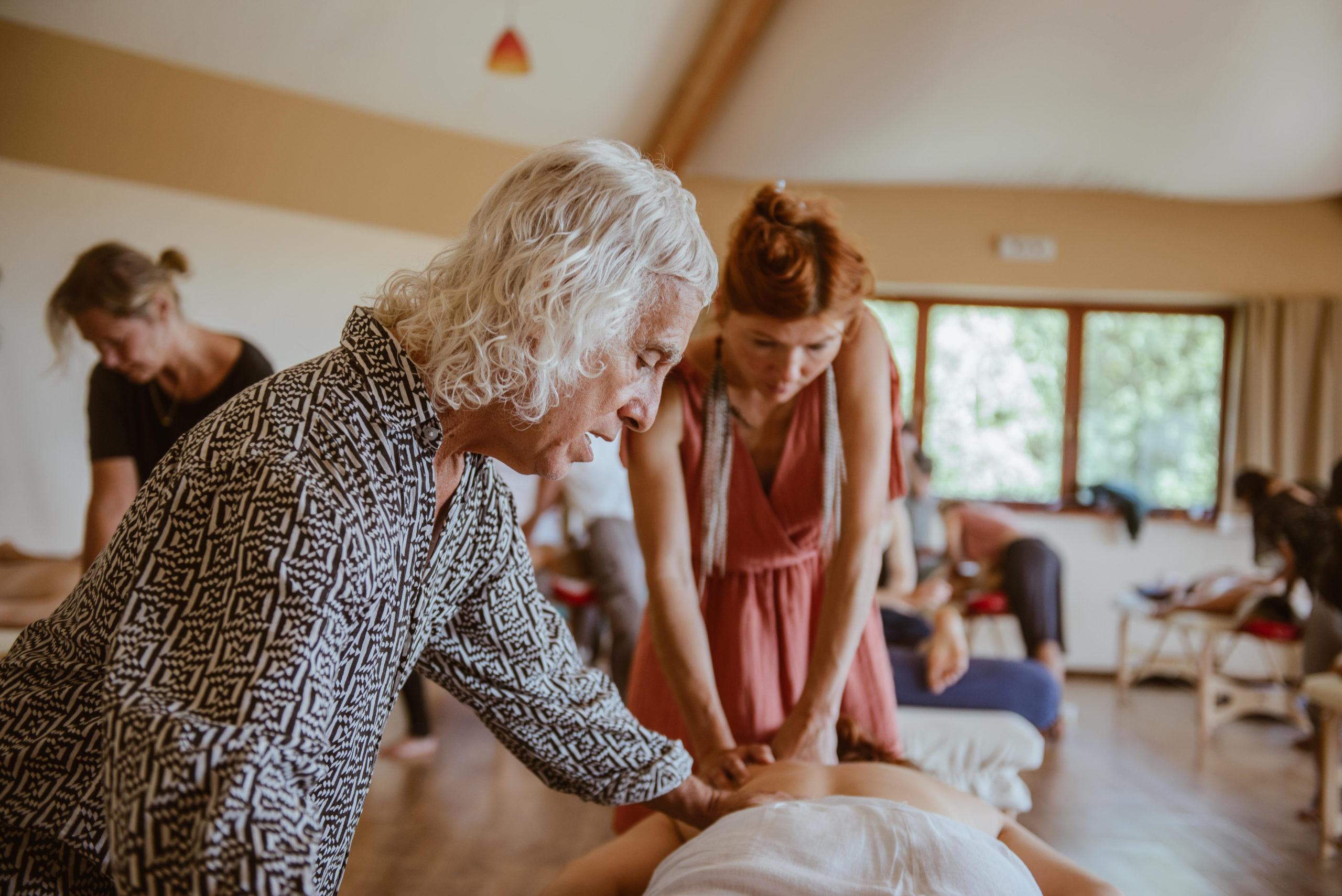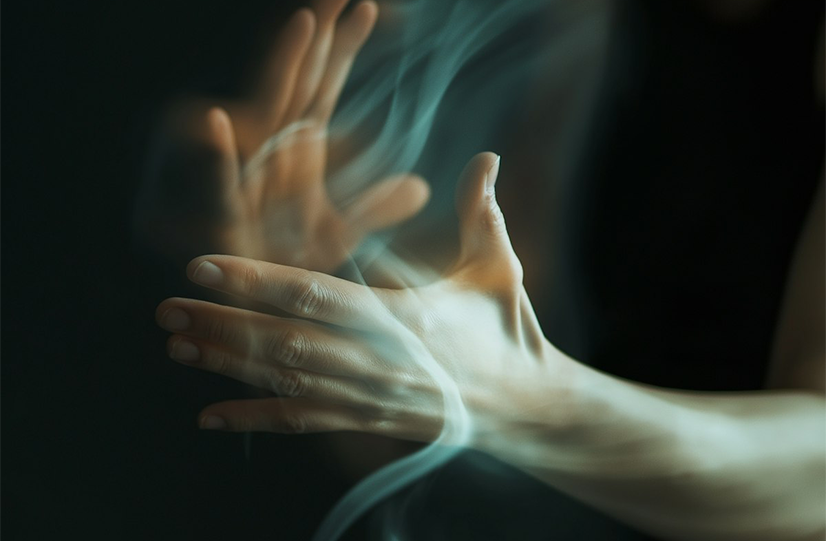
What is MER?
Myofascial Energetic Release is a deep and sensitive approach to touch, offering a holistic path to healing pain. It supports the natural connection between body, emotions, and mind, helping us uncover the roots of chronic tension and discomfort - and learn how to release them.
This work brings relief in cases of both acute and long-standing pain and helps restore freedom of movement and overall functionality, so that individuals can return to a more active, fulfilling life.Improvements often come in many forms: immediate ease from physical and emotional discomfort, lasting structural and functional balance, emotional resilience, clearer psychological patterns, and a quieter, more centered mind.
More than a set of manual techniques, this is a living system - a dynamic, integrative approach that evolves and welcomes other methods, while staying true to its core: restoring flow, balance, and wholeness in the human experience.
Every session begins with presence and touch-based assessment. We tune in to your breath, posture, and fascia to understand where support is needed most. This creates safety and sets the tone for deeper work.
Conscious, connected breath activates your body’s energy flow and calms the nervous system. It helps soften fascia, unlock holding patterns, and prepares your system for deeper release and emotional awareness.
Through slow, sensitive touch, we work directly with the fascia using deep tissue techniques, unwinding, and assisted stretches. This supports the release of pain, restriction, and long-held emotional tension.
We complete with grounding and integration. Gentle holds, stillness, and supportive movement help your body absorb the changes, leaving you calm, aligned, and more connected to yourself.

Curriculum Myofascial Energetic Release
- The 7th module will be integrated into the main curriculum 7 X 50 hours = 350h.
- Additional 10 hours of online courses on trauma, breath and the nervous system will be included with self study.
- Additional 90 hours for 60 sessions (of 1h30 minutes).
- Resulting in a total of 450 hours
Certification Requirements
- Completion of all 7 MER modules.
- Completion of 100% of 2 online courses.
- Submission of session logs for 60 feedback sessions between modules.
Myofascial Energetic Release Training is a deep journey focused on the art of effective work with fascia as well as understanding and practicing holistic work with body, mind and feelings as an organic wholeness. You can join the course at any moment, starting at any module. After each module the participants receive certificates from the Integral Body Institute.
You can begin your training with any module.
Comprehensive Training Overview
This module introduces a new integrative approach to working with breath, movement, and touch in Myofascial Energetic Release, focusing on managing and healing trauma. You will explore how to charge and regulate energy, understanding the fundamentals of working with underlying trauma in the body, including identifying the 27 zones of fear.
Techniques and Fundamentals
Energy Regulation: Learn how to charge and regulate the discharge of energy effectively.
Trauma Fundamentals: Understand the fundamentals of working with underlying trauma, focusing on physiological and emotional aspects, including the identification of 27 zones of fear and how trauma affects the body's fascial systems.
Emotional Engagement and Healing
Pro-Active Practitioner Skills: Align in harmonic resonance with your client, mastering 5 definitive steps to successfully engage emotions.
Myofascial Unwinding: Explore the theory and practice of Myofascial Unwinding for Somatic Emotional Release. This includes supervised practice sessions to deepen understanding and master skills.
Understanding Trauma's Impact: Discuss how daily activities, stress, and repressed emotions contribute to physical tension, spasms, and weaknesses. Understand how emotional energy becomes "frozen" in the body and evolves into personality character structures as described by Wilhelm Reich’s "Frozen History."
Advanced Therapeutic Techniques
De-armouring Techniques: Learn methods to help clients dismantle the 'armour'—psychological and physical defense mechanisms—that protect but also block genuine emotional expression.
Vagus Nerve and Autonomic Response: Understand the role of the Vagus Nerve in trauma response and techniques to restore the flow of a disrupted 'Fight/Flight/Freeze' reaction.
Character Structures and Personal Development: Identify and work through the five different Reichian character structures, understanding how these defense mechanisms form in early life and affect adult behavior.
Integration and Application
Movement Meditations and Trauma Release: Employ trauma release techniques and movement meditations to empower your client towards more embodied emotional awareness.
Practical Application: Engage in practice sessions that reinforce the learning and application of techniques, ensuring participants can confidently apply these methods in their professional practice.
Comprehensive Training Overview
Explore a systematic approach to mobilizing all major joints of the body, enhancing fluid communication through passive movement techniques known as “Joint Release.”
Techniques and Movement Integration
Joint Mobilization: Learn the integrative wave, a fluid passive movement of the whole body to enhance joint mobility.
Somatic Emotional Release: Combine Myofascial Unwinding with breath work, emotional awareness, and release techniques.
Meditation and Practical Application
Body-Mind Integration: Focus on body-mind integration through movement, discovering the body’s unique rhythm.
Meditation Through Touch
Learn to allow touch to arise directly from Universal Source Energy, enhancing the therapeutic experience.
Comprehensive Training Overview
This module is designed to refine and deepen the natural rhythm of breath by working directly with the rib cage, spine, shoulders, and neck. Special focus is placed on hands-on techniques that support energy flow and enhance movement through conscious breath engagement.
Techniques and Integration
Breath Optimization Methods
Discover how to support and amplify the mechanics of inhalation and exhalation, allowing for fuller, more relaxed breathing. These methods increase the therapeutic effect of each Myofascial Energetic Release session.
Structured Session Planning
Learn to weave together multiple approaches into a cohesive session format, creating clear and effective treatment strategies that maximize client benefit.
Evaluation and Application
Detailed Breath Assessment
Use body-reading skills to evaluate how the breath moves through key areas of the body, including the head, neck, ribs, shoulders, and spine—revealing restrictions and guiding your approach.
Integrative Breath & Bodywork
Combine deep tissue and gentle manual techniques with breathwork, tailoring your touch to each client’s unique respiratory pattern for personalized and impactful support.
Comprehensive Training Overview
In this module, you’ll learn a structured approach for working with chronic upper body conditions that don’t respond well to standard bodywork techniques. You’ll gain tools to address complex patterns involving the face, cranium, neck, breath, and arms.
Techniques and Treatment Plans
Spatial Medicine
Understand the spatial relationships between segments of the torso and how these influence therapeutic strategies.
Fascial Network Treatment
Work with the fascial system that supports breathing structures to provide integrated and lasting relief.
Soft Listening Techniques
Learn four advanced techniques to gently release tension from the breath structures, supporting clients in processing shock and trauma.
Comprehensive Upper Body Treatment
Develop targeted treatment plans for pain and dysfunction in the neck, shoulders, elbows, wrists, hands, and jaw—including conditions like TMJ and chronic headaches.
Deep Bodywork and Psychological Insights
Functional Anatomy Mastery
Study the fascial and muscular systems of the breath, face, cranium, and arms, including how they relate to deeper organs like the lungs, liver, and stomach.
Psychological Aspects of Upper Body Tension
Explore the emotional and psychological roots of upper body holding patterns. Learn to support natural trauma release through breath-centered approaches.
Skill Development and Integration
Rotator Cuff Focus
Examine the structure and function of the rotator cuff and apply precise palpation skills to identify and treat imbalances.
Diaphragm and Ribcage Release
Apply specific techniques to release restrictions in the diaphragm, sternum, and ribs, restoring a deeper and more relaxed breath.
Comprehensive Training Overview
This module offers an in-depth approach to assessing and addressing pelvic imbalances using advanced movement and manual techniques aimed at restoring core alignment and integration.
Core and Pelvic Techniques
Myofascial Dialoguing
Engage in a somatic conversation with the tissue to uncover and release unconscious mental and emotional restrictions held in the fascia.
Pelvic Evaluation and Realignment
Learn how to assess pelvic structure, identify imbalances, and apply hands-on techniques to restore alignment and functional mobility.
Deep Core Muscle Release
Work with key myofascial and skeletal structures of the core, including the Gluteus Maximus, Medius, and Minimus, deep lateral rotators, adductors, abductors, and the Iliopsoas.
Emotional and Structural Integration
Mind-Body Connections in Posture
Explore how unresolved emotional experiences shape posture and create tension patterns that affect the relationship between the pelvis and the heart center.
Pelvic Floor and Breath Coordination
Gain insight into the vital functions of the pelvic floor and abdominal muscles, especially the role of the Psoas Complex in breath, posture, and birthing processes. Understand its influence on deep, full-body respiration.
Holistic Approach and Emotional Integration
Individualized Treatment Planning
Create effective treatment strategies that support both structural realignment and emotional release, particularly in restoring the connection between the pelvis and heart.
Integrating Breath and Body
Use guided breathwork to support nervous system regulation, encourage emotional release, and bring cohesion to the entire body-mind system.
Comprehensive Training Overview
This module focuses on advanced techniques for treating the lower body using deep bodywork, joint mobilization, and Myofascial Release. You’ll learn to restore natural movement and relieve pain in the feet, legs, and hips.
Techniques and Tools
Lower Body Release Techniques
Work along the posterior leg line and extend treatment to hips, knees, and feet using deep tissue and mobilization methods.
Assessment Skills
Enhance your ability to assess and treat common issues in the lower limbs through precise palpation and body-reading.
Plantar Fascia & Assisted Stretches
Apply specific techniques to release the plantar fascia and guide assisted stretches to support therapeutic outcomes.
Muscle-Specific Focus
Target key muscle groups including the glutes, TFL, tibialis anterior, hamstrings, adductors, and quadriceps.
Structural Insights and Integration
Myth-Busting & Somatic Dialoguing
Challenge misconceptions around joint issues and explore the emotional roots of pain using body-centered communication tools.
Integrated Approach
Combine theory, meditation, and hands-on practice with techniques like “Tracking” to realign the feet and legs and support holistic healing.
Comprehensive Training Overview
This module offers a powerful approach to relieving chronic pain in the back, neck, and pelvis through deep tissue bodywork and myofascial integration. You’ll gain practical skills to release restrictions along the spine and support your clients' physical and emotional balance.
Key Learning Areas
Myofascial Integration & Breathwork
Understand how fascial contraction causes chronic pain.
Learn breath regulation to support emotional release and structural balance.
Explore the pelvis as a key to grounding, trust, and alignment.
Assessment & Touch Skills
Apply body-reading, palpation, client dialogue, and intuitive sensing.
Refine deep touch using correct body mechanics and “listening hands.”
Practice the '8-point teaching' for sensitive, effective touch.
Holistic Practice & Integration
Combine meditation, theory, and hands-on exchanges.
Focus on major spinal areas: Lumbar/Sacral, Diaphragm, Heart, Thoracic Inlet, Atlas/Occiput, and Pelvis.
Anatomy & Pain Relief Techniques
Study functional anatomy of the spine, neck, and pelvis.
Use four targeted breath release techniques to ease tension and support trauma release.
Support clients in reconnecting with their bodies and self-agency.
